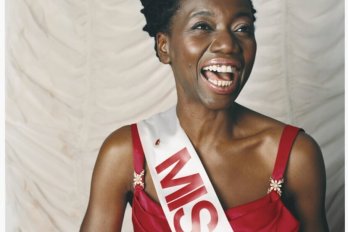tokyo—Onstage in his tight white T-shirt, mini-backpack, and very short shorts, Goldenboy looks like a fat cartoon of a six-year-old Japanese schoolboy. Which is appropriate since he’s sexually attracted to them. “Who likes boys and shota together?” he asks. (Shota refers to sexualized boys and youths.) A young man in a rhinestone tiara and a middle-aged guy holding a huge pink satin cushion gleefully put up their hands along with the rest of the 100-strong, overwhelmingly male audience. “Who likes boys and men together?” Goldenboy asks next. This time, there is a displeased murmur. A group of drunk shirt-and-tied businessmen at the front lower their hands. So do the tiara guy, the cushion guy, and about half the crowd. “I thought so.” Tonight, grown men aren’t hot. The packed house is much more interested in little boys and, astoundingly, proud of it.
This kind of open confession—whether to pedophilia, hating George Bush, or being really obsessed with noodle varieties—is exactly what’s encouraged here at Loft Plus One, tucked away in a basement in Tokyo’s Kabukicho red-light entertainment district. At the twelve-year-old club, whose “acts” range from yakuza mafia bosses to braggart space shuttle engineers to porn stars, one element remains constant: frank, live conversation, no matter how unspeakable the subject.
In Japan, where open argument and confrontation are considered impolite and even vulgar, the soapbox club is a unique experiment. “Loft Plus One crosses the boundary between mainstream and underground culture,” explains owner Yu Hirano. “It’s a discussion space without taboos, where you can listen to the people muzzled in major media.”
Tonight, as tattooed, pierced waitresses carrying beer and fried chicken weave between tables, Goldenboy (the Don King of adult anime) is leading an excited dialogue about Boku no Pico, an animated kiddie-porn dvd. Onstage with him is the film’s haute-dork production team, including a man in aviators smoking a pipe (the writer), a young woman dressed like a French nurse (Pico’s voice), and a goblin-like guy in a bright red cap, a single suspender, and a gold front tooth (the director). Two men with shaved legs, frilly blouses, and giant cartoon masks of the protagonists’ faces periodically wave to the crowd.
As the talent banters over beers, the film rolls in the background. It tells the story of Pico, a hairless little thing you’d swear was a female but for the erections, who has graphic, only slightly pixelated intercourse with a marginally older male in a variety of romantic settings (beach, car). “It’s the world’s first,” boasts Goldenboy. “There’s lots of boy-on-boy in magazines. But this is the first time on dvd.” The team nods proudly. “And the characters are so cute!” adds one of the men onstage, puffing on his cigarillo. The audience laughs. Cushion Guy pulls his pillow up to his chest, revealing that it’s embroidered with a huge Pico, and rocks back and forth. The bright-eyed businessmen gaze up at the stage in adulation. Nobody seems the least bit embarrassed.
Although such public honesty might seem un-Japanese, Hirano says Loft Plus One was actually inspired by traditional izakaya bar-restaurants, for centuries places to bitch about work and generally release one’s true feelings (with the handy excuse of alcohol to hide behind come morning). “There are so many things that can be developed only by face-to-face discussion,” he says. The Japanese may be outwardly reserved, but their obsessions are legendary. Pick an obscure subject and Japan has a fixated otaku subculture devoted to it. A few weeks before Pico night, for instance, Loft Plus One hosted an evening on the increase in bespectacled female comic book characters. “The greatest achievement of Loft Plus One is that otaku culture has been lifted up to the bright side by expressing itself in public,” says Hirano.
And despite the sometimes murky legality (not to mention morality) of the subject matter, the state seems to keep its distance. “Either that or our club can be a good place to gather information for the security police,” Hirano jokes. “Basically, our shows do not conflict with the law because they are just talk. The event for necrophiliacs seems creepy, but I think freedom of thought has to be protected.”
Pico’s creators argue that their film is simply the manifestation of another cultural sub-genre. Japan’s crowded pornography market is highly competitive, so they focused on carving out a very specific niche, conducting extensive Pico research: most popular haircut (short), least popular haircut (buzz), favourite “size” (average). “Every week, we talked,” says Goldenboy. And there were some tough calls. “Dildos? No. Ice cubes? OK.” Yes, it turns them on, but what’s key is that it be cutting-edge.
Not everyone is impressed, however. A disappointed audience member asks why Pico didn’t look more like a little boy instead of a girl with a penis. “Well,” Goldenboy responds after an uncomfortable silence, “we’re sorry you feel that way, but thank you for expressing your opinion. We’re old, so we like youth. Pico is a fantasy. Not a boy, not a girl. Just Pico.”
As dawn approaches, that fantasy starts to deflate. A lengthy exchange about animation techniques shows no signs of ending. Live-action Pico, still in his mask, slouches and discreetly sips beer through a straw. The guy in the tiara is asleep. The question of morals begins to seem as fuzzy as the attention of the audience. One by one they stand, pay their bills, and quietly trudge upstairs into the bright Sunday morning to head home on one of the first trains, where the signs encourage them, for the sake of other passengers, to remain politely silent.




